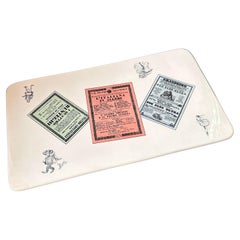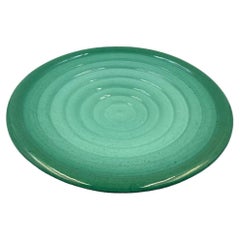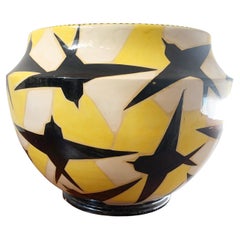Ivos Pacetti Serveware, Ceramics, Silver and Glass
to
1
2
2
2
2
2
1
1
2
2
2
2
2
2
1
632
482
437
405
Creator: Ivos Pacetti
1950s Mid-Century Modern Albisola Ceramic Italian Vide-Poche by Ivos Pacetti
By Ivos Pacetti
Located in Aci Castello, IT
1950s Mid-Century Modern Albisola Ceramic Vide-Poche by Ivos Pacetti
A charming and rare piece of Italian mid-century design, this ceramic vide-poche (catchall tray) was crafted in A...
Category
Mid-20th Century Italian Mid-Century Modern Ivos Pacetti Serveware, Ceramics, Silver and Glass
Materials
Ceramic
$376 Sale Price
20% Off
Italian Vintage Majolica Sugar Bowl in the shape of a Tomato by Pacetti Albisola
By Ivos Pacetti
Located in Roma, IT
I offer for sale an extremely decorative and fun element to set your table.
This vintage jar was made in Italy between the 1950s and 1960s, by the cerami...
Category
Mid-20th Century Italian Mid-Century Modern Ivos Pacetti Serveware, Ceramics, Silver and Glass
Materials
Ceramic, Majolica
Related Items
Midcentury Green Plate / Vide Poche, Giuseppe Mazzotti, Albisola, Italy, 1950
By Giuseppe Mazzotti, Ceramiche di Albisola
Located in Firenze, IT
Midcentury green ceramic plate / centerpiece.
Giuseppe Mazzotti, Albisola, Italy, 1950s.
Signed under the base "M.G.A”
Measure: 3.5 heigh...
Category
1950s Italian Mid-Century Modern Vintage Ivos Pacetti Serveware, Ceramics, Silver and Glass
Materials
Ceramic
$411
H 1.38 in Dm 11.03 in
Ceramic Vase signed by Fenice Albisola for Manlio Trucco - Italy 1930
By Manlio Trucco
Located in Brussels, BE
Ceramic Vase signed by Fenice Albisola for Manlio Trucco - Italy 1930.
Category
1930s Italian Vintage Ivos Pacetti Serveware, Ceramics, Silver and Glass
Materials
Ceramic
Majolica Lily of the Valley Tumblers, Handmade in Italy, S/4
Located in West Chester, PA
Majolica Lily of the Valley Tumbler, Set of 4, Handmade in Italy for The Mane Lion
The Mane Lion was born in 1979 in the heart of Philadelphia's fabled Ma...
Category
2010s Italian Ivos Pacetti Serveware, Ceramics, Silver and Glass
Materials
Ceramic
Mid-Century French Decorative Ceramic Dish / Vide-Poche by Albert Thiry C. 1960s
By Albert Thiry
Located in Auribeau sur Siagne, FR
French ceramic decorative dish (c. 1960s) by Albert Thiry. Boat-shaped ceramic dish with milky-white glazed exterior. Within the dish you find the same base glaze mixed with thistle...
Category
1960s French Mid-Century Modern Vintage Ivos Pacetti Serveware, Ceramics, Silver and Glass
Materials
Ceramic
$423 Sale Price
20% Off
H 1.97 in Dm 12.6 in
Mid century Roger Capron ceramic vide poche with pyjama decoration
By Roger Capron
Located in Henley-on Thames, Oxfordshire
Fine teardrop shaped Roger Capron ceramic vide poche
with pyjama decoration.
Produced at his workshops in Vallauris in the 1950s
Category
Mid-20th Century French Mid-Century Modern Ivos Pacetti Serveware, Ceramics, Silver and Glass
Materials
Ceramic
$601
H 1.58 in W 10.44 in D 2.96 in
Ceramic Vase by Fenice Albisola for Manlio Trucco Italy ca' 1930
By Manlio Trucco
Located in St.Petersburg, FL
An unusual ceramic charger/plate signed by Fenice Albisola for Manlio Trucco - Italy 1930. Handpainted ravens done in a bold graphic style.
Category
1930s Italian Art Deco Vintage Ivos Pacetti Serveware, Ceramics, Silver and Glass
Materials
Ceramic
Guido Gambone Ceramic Decorative Cup Vide-Poches or wall decoration 1950's
By Guido Gambone
Located in Paris, FR
Guido Gambone (1909-1969)
Hand enameled geometric decor on grey glazed ceramic.
Can be used as vide-poche or wall decor
Signed Gambone, Italy with donkey mark. Nice condition
Guido G...
Category
Mid-20th Century Italian Ivos Pacetti Serveware, Ceramics, Silver and Glass
Materials
Ceramic
$1,233 Sale Price
30% Off
H 0.79 in W 6.3 in D 7.88 in
mid century Roger Capron ceramic vide poche with bird motif
By Roger Capron
Located in Henley-on Thames, Oxfordshire
Oval shaped vide poche by Roger Capron decorated to the interior with a bird in colours, supported by three feet. Signed ” Capron – Vallauris C” to the underside. France circa 1955
Category
Mid-20th Century French Mid-Century Modern Ivos Pacetti Serveware, Ceramics, Silver and Glass
Materials
Ceramic
Chicken Shaped Snack Pottery Bowl Vide Poche Mid Century Modern Italian Vintage
By Bitossi, ICS
Located in Bad Säckingen, DE
Charming mid-century modern Italian ceramic bowl in the shape of a stylized chicken, hand-painted in black, white, and red. This whimsical and sculptural piece features an elongated ...
Category
1950s Italian Mid-Century Modern Vintage Ivos Pacetti Serveware, Ceramics, Silver and Glass
Materials
Ceramic, Pottery
$340
H 4.65 in W 8.47 in D 4.34 in
Guido Gambone Large Ceramic Decorative Cup or Vide-Poches 1950's
By Guido Gambone
Located in Paris, FR
Guido Gambone (1909-1969)
Hand enameled with geometric decor characters on glazed ceramic.
Can be used as vide-poche or wall decor
Signed Gambone, Italy with donkey mark. Nice origin...
Category
Mid-20th Century Italian Ivos Pacetti Serveware, Ceramics, Silver and Glass
Materials
Ceramic
$3,524
H 1.19 in W 10.63 in D 7.88 in
Mid-Century French Decorative Ceramic Dish / Vide-Poche by Albert Thiry C. 1960s
By Albert Thiry
Located in Auribeau sur Siagne, FR
French ceramic decorative dish with thistle motif (c. 1960s) by Albert Thiry. Boat-shaped ceramic dish with milky-white glazed exterior. Within the dish you find the same base glaze ...
Category
1960s French Mid-Century Modern Vintage Ivos Pacetti Serveware, Ceramics, Silver and Glass
Materials
Ceramic
$423 Sale Price
20% Off
H 2.37 in W 17.33 in D 13 in
Berndt Friberg for Gustavsberg, Modern Swedish Ceramic Bowl or Vide Poche 1950
By Berndt Friberg
Located in Paris, FR
Berndt Friberg (1899-1981) studio ceramic bowl or vide poche, modern Swedish design for Gustavsberg.
Unique, handmade.
Amazing glaze in blue nuances.
Signed with incised marks.
Category
1950s Vintage Ivos Pacetti Serveware, Ceramics, Silver and Glass
Materials
Ceramic
$939
H 2.76 in Dm 4.73 in
Ivos Pacetti serveware, ceramics, silver and glass for sale on 1stDibs.
Ivos Pacetti serveware, ceramics, silver and glass are available for sale on 1stDibs.



